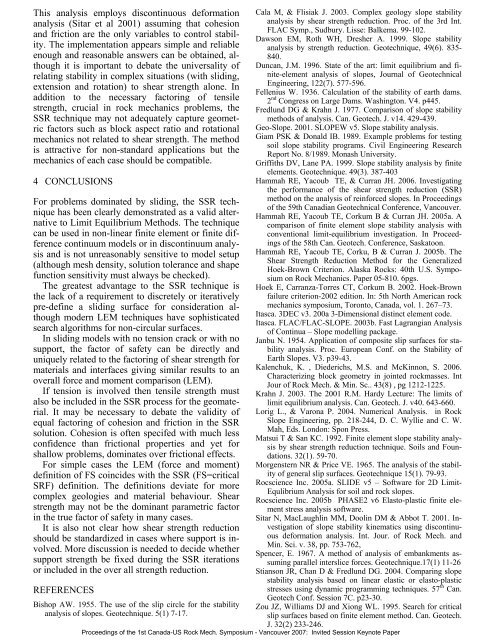Shear Strength Reduction Approach for Slope Stability Analyses
Shear Strength Reduction Approach for Slope Stability Analyses
Shear Strength Reduction Approach for Slope Stability Analyses
- No tags were found...
You also want an ePaper? Increase the reach of your titles
YUMPU automatically turns print PDFs into web optimized ePapers that Google loves.
This analysis employs discontinuous de<strong>for</strong>mationanalysis (Sitar et al 2001) assuming that cohesionand friction are the only variables to control stability.The implementation appears simple and reliableenough and reasonable answers can be obtained, althoughit is important to debate the universality ofrelating stability in complex situations (with sliding,extension and rotation) to shear strength alone. Inaddition to the necessary factoring of tensilestrength, crucial in rock mechanics problems, theSSR technique may not adequately capture geometricfactors such as block aspect ratio and rotationalmechanics not related to shear strength. The methodis attractive <strong>for</strong> non-standard applications but themechanics of each case should be compatible.4 CONCLUSIONSFor problems dominated by sliding, the SSR techniquehas been clearly demonstrated as a valid alternativeto Limit Equilibrium Methods. The techniquecan be used in non-linear finite element or finite differencecontinuum models or in discontinuum analysisand is not unreasonably sensitive to model setup(although mesh density, solution tolerance and shapefunction sensitivity must always be checked).The greatest advantage to the SSR technique isthe lack of a requirement to discretely or iterativelypre-define a sliding surface <strong>for</strong> consideration althoughmodern LEM techniques have sophisticatedsearch algorithms <strong>for</strong> non-circular surfaces.In sliding models with no tension crack or with nosupport, the factor of safety can be directly anduniquely related to the factoring of shear strength <strong>for</strong>materials and interfaces giving similar results to anoverall <strong>for</strong>ce and moment comparison (LEM).If tension is involved then tensile strength mustalso be included in the SSR process <strong>for</strong> the geomaterial.It may be necessary to debate the validity ofequal factoring of cohesion and friction in the SSRsolution. Cohesion is often specifed with much lessconfidence than frictional properties and yet <strong>for</strong>shallow problems, dominates over frictional effects.For simple cases the LEM (<strong>for</strong>ce and moment)definition of FS coincides with the SSR (FS=criticalSRF) definition. The definitions deviate <strong>for</strong> morecomplex geologies and material behaviour. <strong>Shear</strong>strength may not be the dominant parametric factorin the true factor of safety in many cases.It is also not clear how shear strength reductionshould be standardized in cases where support is involved.More discussion is needed to decide whethersupport strength be fixed during the SSR iterationsor included in the over all strength reduction.REFERENCESCala M, & Flisiak J. 2003. Complex geology slope stabilityanalysis by shear strength reduction. Proc. of the 3rd Int.FLAC Symp., Sudbury. Lisse: Balkema. 99-102.Dawson EM, Roth WH, Dresher A. 1999. <strong>Slope</strong> stabilityanalysis by strength reduction. Geotechnique, 49(6). 835-840.Duncan, J.M. 1996. State of the art: limit equilibrium and finite-elementanalysis of slopes, Journal of GeotechnicalEngineering, 122(7). 577-596.Fellenius W. 1936. Calculation of the stability of earth dams.2 nd Congress on Large Dams. Washington. V4. p445.Fredlund DG & Krahn J. 1977. Comparison of slope stabilitymethods of analysis. Can. Geotech. J. v14. 429-439.Geo-<strong>Slope</strong>. 2001. SLOPEW v5. <strong>Slope</strong> stability analysis.Giam PSK & Donald IB. 1989. Example problems <strong>for</strong> testingsoil slope stability programs. Civil Engineering ResearchReport No. 8/1989. Monash University.Griffiths DV, Lane PA. 1999. <strong>Slope</strong> stability analysis by finiteelements. Geotechnique. 49(3). 387-403Hammah RE, Yacoub TE, & Curran JH. 2006. Investigatingthe per<strong>for</strong>mance of the shear strength reduction (SSR)method on the analysis of rein<strong>for</strong>ced slopes. In Proceedingsof the 59th Canadian Geotechnical Conference, Vancouver.Hammah RE, Yacoub TE, Corkum B & Curran JH. 2005a. Acomparison of finite element slope stability analysis withconventional limit-equilibrium investigation. In Proceedingsof the 58th Can. Geotech. Conference, Saskatoon.Hammah RE, Yacoub TE, Corku, B & Curran J. 2005b. The<strong>Shear</strong> <strong>Strength</strong> <strong>Reduction</strong> Method <strong>for</strong> the GeneralizedHoek-Brown Criterion. Alaska Rocks: 40th U.S. Symposiumon Rock Mechanics. Paper 05-810. 6pgs.Hoek E, Carranza-Torres CT, Corkum B. 2002. Hoek-Brownfailure criterion-2002 edition. In: 5th North American rockmechanics symposium, Toronto, Canada, vol. 1. 267–73.Itasca. 3DEC v3. 200a 3-Dimensional distinct element code.Itasca. FLAC/FLAC-SLOPE. 2003b. Fast Lagrangian Analysisof Continua – <strong>Slope</strong> modelling package.Janbu N. 1954. Application of composite slip surfaces <strong>for</strong> stabilityanalysis. Proc. European Conf. on the <strong>Stability</strong> ofEarth <strong>Slope</strong>s. V3. p39-43.Kalenchuk, K. , Diederichs, M.S. and McKinnon, S. 2006.Characterizing block geometry in jointed rockmasses. IntJour of Rock Mech. & Min. Sc.. 43(8) , pg 1212-1225.Krahn J. 2003. The 2001 R.M. Hardy Lecture: The limits oflimit equilibrium analysis. Can. Geotech. J. v40. 643-660.Lorig L., & Varona P. 2004. Numerical Analysis. in Rock<strong>Slope</strong> Engineering, pp. 218-244, D. C. Wyllie and C. W.Mah, Eds. London: Spon Press.Matsui T & San KC. 1992. Finite element slope stability analysisby shear strength reduction technique. Soils and Foundations.32(1). 59-70.Morgenstern NR & Price VE. 1965. The analysis of the stabilityof general slip surfaces. Geotechnique 15(1). 79-93.Rocscience Inc. 2005a. SLIDE v5 – Software <strong>for</strong> 2D Limit-Equlibrium Analysis <strong>for</strong> soil and rock slopes.Rocscience Inc. 2005b PHASE2 v6 Elasto-plastic finite elementstress analysis software.Sitar N, MacLaughlin MM, Doolin DM & Abbot T. 2001. Investigationof slope stability kinematics using discontinuousde<strong>for</strong>mation analysis. Int. Jour. of Rock Mech. andMin. Sci. v. 38, pp. 753-762,Spencer, E. 1967. A method of analysis of embankments assumingparallel interslice <strong>for</strong>ces. Geotechnique.17(1) 11-26Stianson JR, Chan D & Fredlund DG. 2004. Comparing slopestability analysis based on linear elastic or elasto-plasticstresses using dynamic programming techniques. 57 th Can.Geotech Conf. Session 7C. p23-30.Zou JZ, Williams DJ and Xiong WL. 1995. Search <strong>for</strong> criticalslip surfaces based on finite element method. Can. Geotech.J. 32(2) 233-246.Proceedings of the 1st Canada-US Rock Mech. Symposium - Vancouver 2007: Invited Session Keynote PaperBishop AW. 1955. The use of the slip circle <strong>for</strong> the stabilityanalysis of slopes. Geotechnique. 5(1) 7-17.
















